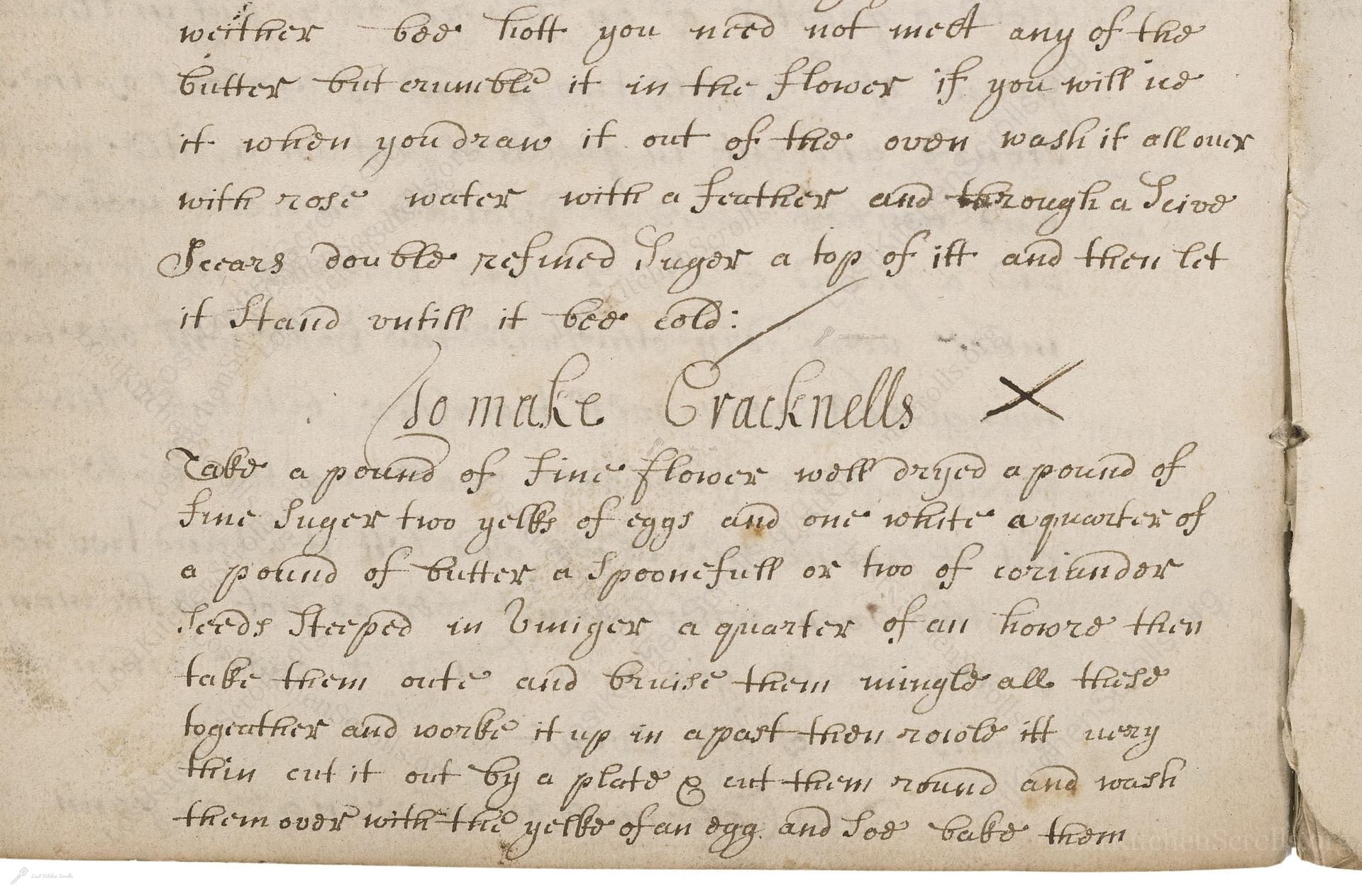To Make Cracknells
From the treasured pages of Cookery book of Ann Goodenough
Written by Ann Goodenough

To Make Cracknells
"Take a pound of fine Flower well dryed a pound of fine Suger two yelks of eggs and one whitt a quarter of a spoonfull or two of coriandor Seads steeped in vineger a quarter of an hower then take them out and bruise them mingle all these togeather and worke itt up in apart then rowle itt very thin cutt itt out by a plate & cutt them round and wash them over with the yelke of an egg and Soe bake them"
Note on the Original Text
The recipe is written in the concise, somewhat telegraphic prose characteristic of 18th-century English receipt books, with little to no punctuation and many words spelled phonetically (e.g., 'flower' for 'flour', 'suger' for 'sugar', 'howre' for 'hour'). Quantities are mostly by weight but baking times and temperatures are imprecise, reflecting the cook's expected prior knowledge. The inclusion of coriander steeped in vinegar reflects both spice trade influence and period flavor preferences.

Title
Cookery book of Ann Goodenough (1738)
You can also click the book image above to peruse the original tome
Writer
Ann Goodenough
Era
1738
Publisher
Unknown
Background
A delightful journey into the kitchens of early 18th-century England, this collection captures the flair and flavors of its time with recipes crafted by the inventive Ann Goodenough. Expect a charming medley of hearty roasts, comforting pies, and time-honored confections, perfect for those wishing to dine as they did in Georgian days.
Kindly made available by
Folger Shakespeare Library
This recipe for Cracknells hails from the 18th century, cared for by Ann Goodenough, an active cook between 1700 and 1775. Cracknells themselves were thin, crisp biscuits, often flavored with aromatic spices and enjoyed as both a sweet treat and a tea-time nibble in Georgian England. At this time, recipes were recorded as aides-mémoire rather than for precise instruction, meant for cooks already skilled in the kitchen. The social context was one of country estates and townhouses where such delicacies signified refinement and hospitality.

Cooks of the period would have used a wooden bowl for mixing and a sturdy wooden spoon or their hands to combine the ingredients. Coriander seeds were bruised using a mortar and pestle. The thin dough would be rolled with a wooden rolling pin and cut with a small plate or a knife (as specific cutters were not common). The biscuits were baked in a wood-fired oven, with heat judged by experience rather than thermometer, and brushed with egg yolk using a simple feather or brush fashioned from tied herb sprigs.
Prep Time
20 mins
Cook Time
15 mins
Servings
24
We've done our best to adapt this historical recipe for modern kitchens, but some details may still need refinement. We warmly welcome feedback from fellow cooks and culinary historians — your insights support the entire community!
Ingredients
- 1 pound plain flour, well dried
- 1 pound fine white sugar
- 2 egg yolks
- 1 egg white
- 1–2 teaspoons coriander seeds (substitute: lightly crushed fennel seeds if unavailable)
- 1/2 tablespoon vinegar (for steeping)
- Additional egg yolk for brushing
Instructions
- To make these delightful Cracknells in a modern kitchen, begin by combining 1 pound of well-dried plain (all-purpose) flour with 1 pound of fine white sugar in a mixing bowl.
- Lightly beat two egg yolks and one egg white, and add them to the dry mixture.
- For the aroma, take 1 to 2 teaspoons of coriander seeds, steep them in a splash (about 1/2 tablespoon) of vinegar for 15 minutes.
- Afterwards, drain, crush the seeds (using a mortar and pestle), and add them to your mixture.
- Work the dough together until just combined—it will not be overly wet.
- Roll the dough out very thinly, perhaps 1/8–1/10 inch thick, on a lightly floured surface.
- Use a plate or round cutter to shape the Cracknells into rounds.
- Brush the tops with an egg yolk for a lovely golden shine.
- Arrange them on a baking tray and bake in a moderate oven—about 340°F (170°C)—until just golden and crisp, watching carefully as baking time may vary based on thickness (approximately 10–15 minutes).
Estimated Calories
120 per serving
Cooking Estimates
It takes about 20 minutes to prepare the ingredients and dough, plus 10–15 minutes to bake the Cracknells until golden and crisp. Each Cracknell, if the dough is rolled and cut into about 24 rounds, has around 120 calories.
As noted above, we have made our best effort to translate and adapt this historical recipe for modern kitchens, taking into account ingredients nowadays, cooking techniques, measurements, and so on. However, historical recipes often contain assumptions that require interpretation.
We'd love for anyone to help improve these adaptations. Community contributions are highly welcome. If you have suggestions, corrections, or cooking tips based on your experience with this recipe, please share them below.
Join the Discussion
Rate This Recipe
Dietary Preference
Main Ingredients
Culinary Technique
Occasions

Den Bockfisch In Einer Fleisch Suppen Zu Kochen
This recipe hails from a German manuscript cookbook compiled in 1696, a time whe...

Die Grieß Nudlen Zumachen
This recipe comes from a rather mysterious manuscript cookbook, penned anonymous...

Ein Boudain
This recipe comes from an anonymous German-language manuscript cookbook from 169...

Ein Gesaltzen Citroni
This recipe, dating from 1696, comes from an extensive anonymous German cookbook...
Browse our complete collection of time-honored recipes



